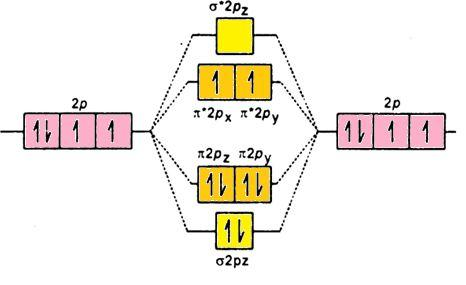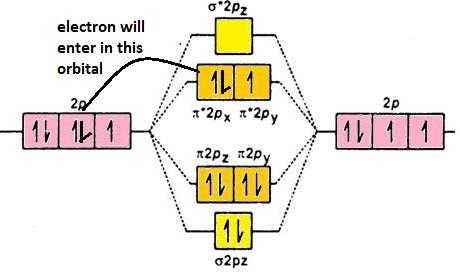
During change of ${{\text{O}}_{2}}$ to ${{\text{O}}_{2}}^{-}$ ion, the electron adds on which one of the following orbitals?
$\begin{align}
& \text{A}\text{. }\pi \text{ orbital} \\
& \text{B}\text{. }{{\sigma }^{*}}\text{orbital} \\
& \text{C}\text{. }\sigma \text{ orbital} \\
& \text{D}\text{. }{{\pi }^{*}}\text{ orbital} \\
\end{align}$
Answer
552.9k+ views
Hint: The question deals with diatomic molecule which are ${{\text{O}}_{2}}$ and ${{\text{O}}_{2}}^{-}$. Diatomic molecules and their configuration comes under Molecular orbital theory. It is a method that is used to describe the electronic structure of diatomic molecules using quantum mechanics.
Complete Solution:
The addition of electrons in which an orbital cannot be explained without knowing what is molecular orbital theory and its general configuration. Let us first see the definition; This theory uses a linear combination of atomic orbitals which represents molecular orbitals that result from bonds between atomic orbitals. It is categorized into three types: bonding, antibonding and non-bonding.
Oxygen molecule or ${{\text{O}}_{2}}$- The electronic configuration of oxygen (Z = 8) in its ground state is $1{{\text{s}}^{2}}2{{\text{s}}^{2}}2{{\text{p}}^{4}}$. Oxygen atoms have 8 electrons thus; there are 16 electrons in ${{\text{O}}_{2}}$ molecule. The electronic configuration of ${{\text{O}}_{2}}$:
${{\text{O}}_{2}}$:${{\sigma }_{\text{1s}}}^{2}{{\sigma }^{*}}{{_{1\text{s}}}^{2}}{{\sigma }_{2\text{s}}}^{2}{{\sigma }^{*}}{{_{2\text{s}}}^{2}}{{\sigma }_{2\text{pz}}}^{2}{{\pi }_{2\text{px}}}^{2}{{\pi }_{2\text{py}}}^{2}{{\pi }^{*}}{{_{2\text{px}}}^{1}}{{\pi }^{*}}{{_{2\text{py}}}^{1}}$; the electrons in molecular orbitals are filled according to Hund’s Rule and Aufbau rule.
- Hund’s Rule: Each orbital in a subshell is filled with one electron before its following orbital is filled again and all electrons which are singly filled in the orbitals have the same spin. See the difference between the configurations,
$\text{CORRECT}-\text{ }\begin{matrix}
\uparrow & \uparrow & \uparrow & {} & {} \\
\end{matrix}
\\
\text{INCORRECT}-\text{ }\begin{matrix}
\uparrow \downarrow & \uparrow & {} & {} & {} \\
\end{matrix} $
- Aufbau Rule- It states that in the ground state of an atom; electrons fill orbitals of the lowest energy levels before occupying higher levels. Like 3d is filled before 4s. Its molecular orbital diagram is (p-orbital):

Let us see the electronic configuration of${{\text{O}}_{2}}^{-}$ it has total ( 8 + 8 + 1) electrons in it that is total 17 electrons:
${{\text{O}}_{2}}^{-}$: ${{\sigma }_{\text{1s}}}^{2}{{\sigma }^{*}}{{_{1\text{s}}}^{2}}{{\sigma }_{2\text{s}}}^{2}{{\sigma }^{*}}{{_{2\text{s}}}^{2}}{{\sigma }_{2\text{pz}}}^{2}{{\pi }_{2\text{px}}}^{2}{{\pi }_{2\text{py}}}^{2}{{\pi }^{*}}{{_{2\text{px}}}^{2}}{{\pi }^{*}}{{_{2\text{py}}}^{1}}$: addition of electron took place in the antibonding orbital which is $\pi _{2\text{px}}^{*}$, the number of electrons has increased from 1 to 2 in that orbital. Its molecular orbital diagram is (p-orbital):

Thus, the correct answer to this question is the incoming electron added to ${{\pi }^{*}}$
So, the correct answer is “Option D”.
Note: The electronic configuration for elements having electrons greater than 14 electrons is different with the configuration of elements having electrons less than equal to 14. Let us see the electronic configuration:
(1) Greater than 14 electrons: ${{\sigma }_{\text{1s}}}{{\sigma }^{*}}_{1\text{s}}{{\sigma }_{2\text{s}}}{{\sigma }^{*}}_{2\text{s}}{{\sigma }_{2\text{pz}}}{{\pi }_{2\text{px}}}{{\pi }_{2\text{py}}}{{\pi }^{*}}_{2\text{px}}{{\pi }^{*}}_{2\text{py}}$
(2) Electrons less than equal to 14 electrons: ${{\sigma }_{\text{1s}}}{{\sigma }^{*}}_{1\text{s}}{{\sigma }_{2\text{s}}}{{\sigma }^{*}}_{2\text{s}}{{\pi }_{2\text{px}}}{{\pi }_{2\text{py}}}{{\pi }^{*}}_{2\text{px}}{{\sigma }_{2\text{pz}}}{{\pi }^{*}}_{2\text{py}}\sigma _{2\text{pz}}^{*}$
Complete Solution:
The addition of electrons in which an orbital cannot be explained without knowing what is molecular orbital theory and its general configuration. Let us first see the definition; This theory uses a linear combination of atomic orbitals which represents molecular orbitals that result from bonds between atomic orbitals. It is categorized into three types: bonding, antibonding and non-bonding.
Oxygen molecule or ${{\text{O}}_{2}}$- The electronic configuration of oxygen (Z = 8) in its ground state is $1{{\text{s}}^{2}}2{{\text{s}}^{2}}2{{\text{p}}^{4}}$. Oxygen atoms have 8 electrons thus; there are 16 electrons in ${{\text{O}}_{2}}$ molecule. The electronic configuration of ${{\text{O}}_{2}}$:
${{\text{O}}_{2}}$:${{\sigma }_{\text{1s}}}^{2}{{\sigma }^{*}}{{_{1\text{s}}}^{2}}{{\sigma }_{2\text{s}}}^{2}{{\sigma }^{*}}{{_{2\text{s}}}^{2}}{{\sigma }_{2\text{pz}}}^{2}{{\pi }_{2\text{px}}}^{2}{{\pi }_{2\text{py}}}^{2}{{\pi }^{*}}{{_{2\text{px}}}^{1}}{{\pi }^{*}}{{_{2\text{py}}}^{1}}$; the electrons in molecular orbitals are filled according to Hund’s Rule and Aufbau rule.
- Hund’s Rule: Each orbital in a subshell is filled with one electron before its following orbital is filled again and all electrons which are singly filled in the orbitals have the same spin. See the difference between the configurations,
$\text{CORRECT}-\text{ }\begin{matrix}
\uparrow & \uparrow & \uparrow & {} & {} \\
\end{matrix}
\\
\text{INCORRECT}-\text{ }\begin{matrix}
\uparrow \downarrow & \uparrow & {} & {} & {} \\
\end{matrix} $
- Aufbau Rule- It states that in the ground state of an atom; electrons fill orbitals of the lowest energy levels before occupying higher levels. Like 3d is filled before 4s. Its molecular orbital diagram is (p-orbital):

Let us see the electronic configuration of${{\text{O}}_{2}}^{-}$ it has total ( 8 + 8 + 1) electrons in it that is total 17 electrons:
${{\text{O}}_{2}}^{-}$: ${{\sigma }_{\text{1s}}}^{2}{{\sigma }^{*}}{{_{1\text{s}}}^{2}}{{\sigma }_{2\text{s}}}^{2}{{\sigma }^{*}}{{_{2\text{s}}}^{2}}{{\sigma }_{2\text{pz}}}^{2}{{\pi }_{2\text{px}}}^{2}{{\pi }_{2\text{py}}}^{2}{{\pi }^{*}}{{_{2\text{px}}}^{2}}{{\pi }^{*}}{{_{2\text{py}}}^{1}}$: addition of electron took place in the antibonding orbital which is $\pi _{2\text{px}}^{*}$, the number of electrons has increased from 1 to 2 in that orbital. Its molecular orbital diagram is (p-orbital):

Thus, the correct answer to this question is the incoming electron added to ${{\pi }^{*}}$
So, the correct answer is “Option D”.
Note: The electronic configuration for elements having electrons greater than 14 electrons is different with the configuration of elements having electrons less than equal to 14. Let us see the electronic configuration:
(1) Greater than 14 electrons: ${{\sigma }_{\text{1s}}}{{\sigma }^{*}}_{1\text{s}}{{\sigma }_{2\text{s}}}{{\sigma }^{*}}_{2\text{s}}{{\sigma }_{2\text{pz}}}{{\pi }_{2\text{px}}}{{\pi }_{2\text{py}}}{{\pi }^{*}}_{2\text{px}}{{\pi }^{*}}_{2\text{py}}$
(2) Electrons less than equal to 14 electrons: ${{\sigma }_{\text{1s}}}{{\sigma }^{*}}_{1\text{s}}{{\sigma }_{2\text{s}}}{{\sigma }^{*}}_{2\text{s}}{{\pi }_{2\text{px}}}{{\pi }_{2\text{py}}}{{\pi }^{*}}_{2\text{px}}{{\sigma }_{2\text{pz}}}{{\pi }^{*}}_{2\text{py}}\sigma _{2\text{pz}}^{*}$
Recently Updated Pages
Master Class 8 Maths: Engaging Questions & Answers for Success

Class 8 Question and Answer - Your Ultimate Solutions Guide

Master Class 7 Maths: Engaging Questions & Answers for Success

Class 7 Question and Answer - Your Ultimate Solutions Guide

Master Class 6 Maths: Engaging Questions & Answers for Success

Class 6 Question and Answer - Your Ultimate Solutions Guide

Trending doubts
Which animal has three hearts class 11 biology CBSE

Which hormone is responsible for fruit ripening a Ethylene class 11 biology CBSE

How do I convert ms to kmh Give an example class 11 physics CBSE

Define cubit handspan armlength and footspan class 11 physics CBSE

Write a short note on the Chipko movement class 11 biology CBSE

What are the Characteristics of Sound Waves?




